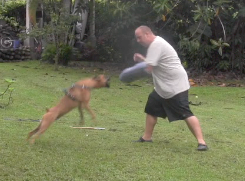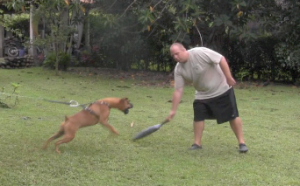 How To Train A Protection Dog- Case Study
How To Train A Protection Dog- Case Study
I’ve recently started working with a dog here in Costa Rica for protection training. The owner wants the dog to be able to protect the family and home in case of a burglary or other invasion.
With a lot of frequency I’m asked how to train a protection dog. At our Salt Lake City dog training company we get several calls a month from people looking to have a guard dog or protection dog. Many might also know that we run a protection dogs for sale company.
The short answer I give most people is, ‘You can’t’.
I don’t say that to be rude or elitist. It’s just a simple reality that nearly every dog out there can not be trained to be a protection dog.
When people call our company looking for this type of training and I tell them the reality I often hear the protests:
- But my dog is really smart.
- My dog is already aggressive.
- My dog wants to please me. He’ll protect me if I’m in danger. If push comes to shove I know he’d protect me.
-He barks at people already so I think he has what it takes.
- I just know that he’s capable.
Again, not to sound like a jerk, but none of these things have any bearing. Let me go through them really quick.
How To Train A Protection Dog- What Doesn’t Matter
- It doesn’t matter how smart your dog is. Some of our most effective soldiers aren’t terribly bright. (Don’t take offense here. I love our military and am grateful for the men and women who serve. It’s just reality, though, that in any given group there are those who aren’t intelligent.) But they have other drives and capabilities that allow them to be very smart. Don’t get me wrong, if a dog is smart I see that as a good thing but intelligence is very far down on the priority list in how to train a protection dog. It just doesn’t matter that much.
- It never fails that ever month or so we’ll get a call from a certain kind of dog owner. Unfortunately, the modus operandi is often the same. It’s a young guy, he’s got a pit bull or a Rottweiler, and he wants to train his dog to attack on command and brags about the dog ‘already being aggressive.’ This type of dog isn’t capable of being a protection dog. Most of these dogs who belong to these knuckle-heads are poorly socialized, lack confidence, and are acting aggressive out of fear or misplaced territorial-ness. Not the recipe for a loyal defender. Unfortunately, I’ve had very little success in convincing owners of these dogs that they are looking at things all wrong and are better suited for stuffed animal ownership than live animal ownership.
- The BIGGEST myth I’ve seen in protection dog training is that, if a dog loves you, he’ll protect you. You can find message boards all over the internet with this fallacious principle. Does it happen? Do dogs protect their owners out of love? Sure, it happens. I’ve seen news stories here and there of a dog protecting against a home invasion, a robbery, a kidnapping. The truth is, though, that for every one of those stories you show me I can give you a dozen instances of someone breaking into a home and the dog doing nothing. In fact, I’ve even seen a few news stories debunking this entire myth. And while I’m not the type of guy that says ‘well, if it’s on the news it must be true’ I can tell you from personal experience that these experiences are accurate.
Dogs are no different. Very few dogs have the natural drives for real protection and very few dogs have actually been trained to deal with a threat. The absence of those things means that, most of the time, a dog won’t try to defend it’s owner in any meaningful way. Notice I said ‘meaningful’. I say that because many dog owners attempt to call me on this. They’ll tell me how their dog barks at ‘threats’ and acts aggressive. There is a big difference between barking at a problem and offering viable protection.
- Speaking of barking at people, let me address this one. Many dog owners believe that, because their dog barks through the window or gate, that they are protective and will defend if necessary. Not so. The most neurotic, terrified, hide-under-the-bed dogs will bark behind a gate. That isn’t very meaningful in gaging a protection dog candidate.
- ‘I just know that he’s capable’. I’ve heard this one a lot from dog owners who absolutely love their dog and think their dog capable of anything and everything. I love my dogs as well. But I’m realistic in realizing that one is trained for protection and one is trained for getting her ears pulled on by my daughters.
So that leaves the obvious question. What is the reality on how to train a protection dog?
How To Train A Protection Dog- What Kind Of Training Do You Need?
Whenever I sit down with a prospective client and the topic is how to train a protection dog, I always give the example of ‘Karate vs. Military’. Allow me to explain more.
I’ve got a six year old daughter. When she was five she was in karate. It turned out she didn’t like it and she stopped doing it but that is beside the point. She learned in karate how to block, kick, punch and more. She learned angles for how to fall, how to defend, and techniques for various types of attacks.
Was any of it real? Of course not. It was all a game. It was fun and she in no way thought she was in danger.
Now, let’s say she stuck with karate until she was 18. It’s all studio work, mind you, but by that time she’s become very good at Karate. But is it real defense or protection? More than likely it’s not. Put my 18 year old daughter in a dangerous situation and she’s BETTER equipped, had she done Karate for years, than most but it’s still just ‘theoretical’ training at that point that has never been really tested.
 Now say, at 18, she goes into the military. Now all that training she has gives her a leg up but now they start putting her in scenarios that are more ‘true to life’. Her training can now hurt her and her self-defense training now takes on whole new layers. Through the reality of the scenarios her background in Karate now gives her viable protection.
Now say, at 18, she goes into the military. Now all that training she has gives her a leg up but now they start putting her in scenarios that are more ‘true to life’. Her training can now hurt her and her self-defense training now takes on whole new layers. Through the reality of the scenarios her background in Karate now gives her viable protection.
We train the same way for protection dogs. In the beginning we employ what is called prey drive. That is the dog’s desire to chase, grab, hunt, etc. We use that to teach the dog how to properly target, bite, and hold onto a towel or sack. From that towel we graduate to a larger bite tug. From the tug we graduate to a leg or arm sleeve. From there we graduate to a body bite suit.
For most dogs, at this point, they ‘appear’ to be protection dogs. In fact, many unscrupulous dog trainers sell dogs like this claiming they are protection dogs when in reality they are dogs that know Karate.
True protection training happens when we take the dog who has learned ‘Karate’ and bring in what is called defense drive. That is the dog’s desire to defend himself, his property, his family, etc. At this stage in the training we make it more real.
This is the reason why most dogs can’t be trained as protection dogs. Very few dogs have the right balance of enough, but not too much, of prey drive and defense drive. Not too many dogs can learn to work with clear heads utilizing those drives in various scenarios.
It’s not likely to find a dog off the street that is capable.
This is what I normally tell most people. In fact, I gave a variation of this same speech when approached by a new friend here in Costa Rica about training his dog for protection.
I told him that it likely wasn’t possible but that we’d give it a try. I was very shocked. He tested great and I’ll be keeping you posted on his progress as he goes along.
The video below shows some of our initial training. It’s in Spanish, so unless you speak it you’ll be left to just the visuals. Enjoy.







